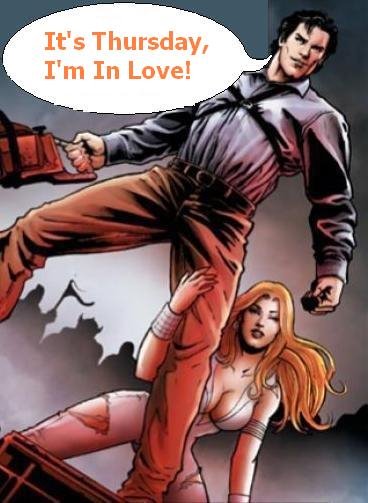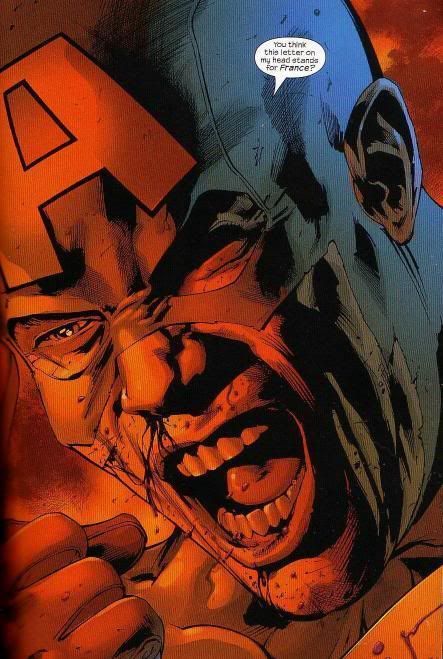Ra's rivals Batman for cunning and intelligence. Unlike other Bat-villains, Ra's actually shows Batman the respect he deserves, calling him "Detective" and acknowledging him as an equal. And Liam Neeson's portrayal of Ra's in "Batman Begins" was just brilliant. Oh, don't tell me you couldn't figure out that Henri Ducard was actually just an alias and Ken Watanabe was a fake Ra's?
Wizard Universe got Grant Morrison, the man who's bringing back Ra's in the current arc, to interview legendary artist Neal Adams. Doesn't Morrison (the bald dude on the left) look like some 80s pop singer? Moby! He looks like Moby!
THE WIZARD CONVERSATION: GRANT MORRISON AND NEAL ADAMS
As Ra’s al Ghul returns to face the Dark Knight, Morrison grills Ra’s co-creator Adams on the Bat-villain’s past
Posted November 13, 2007 3:40 PM |
Grant Morrison admits he gave up a lot to start his Batman collection.
“I swapped all my old Steve Ditko Spider-Man comics for Neal Adams’ Batman,” says Morrison, clearly not regretting the decision a bit. “I loved that stuff.”
The best part about this confession? He gives it to Adams himself, chatting with the legendary artist about November’s reintroduction of the Adams-designed Batman rogue Ras’ al Ghul in Batman #670 and continuing across the Bat-books throughout the month and beyond.
Debuting in 1971’s Batman #232, with art by Adams and a script from equally acclaimed writer Dennis O’Neil, Ra’s left a lasting impression on the Batman mythos, from his bewitching daughter Talia, his death-defying Lazarus Pit and even his role in 2005’s “Batman Begins.” With Morrison giddy to talk to one of his comic book heroes and Adams as elegant a statesman for comics as the medium’s ever seen, the two spoke about every aspect of the master villain and what’s next for comics.—KIEL PHEGLEY
MORRISON: I first encountered Ra’s Al Ghul in those Denny O’Neil and [Adams] books, and that’s where I go, because that’s where the character was born and that’s where the heart and soul of it is. I think [writer] Greg Rucka killed him quite effectively [in Batman: Death and the Maidens]. He made it difficult for us to bring him back, but I came up with a really good take on how to bring him back, so that was fun.
MORRISON: It’s a challenge to bring the character back. I tied it into all the mythology, so to go back to it there’s no question. I looked again at the characters that I’m handling in the crossover—characters like the Sensei, who again is one of Neal’s I believe, and that Deadman mythology of Nanda Parbat. It was more going back to the source so I could do something that feels faithful to that.
ADAMS: I can’t wait to see it.
MORRISON: Did you expect [Ra’s Al Ghul] to survive this long, Neal, and make it into the movies and stuff?
ADAMS: No. And I never do. When you start that stuff, you never know what you’re going to do. My feeling about what my job is, is to do the best job I can, and if it turns into something, it turns into something. I’ve been very fortunate that the characters that I’ve done, either created or partially created or had a hand in, do seem to live on and really attract a lot of attention, even secondary characters.
MORRISON: That costume you did was the only reason people remembered Havok. [Laughs]
ADAMS: He’s got no highlights! But there is a tendency for somebody who has had a lot of experience and who really, really loves what they do to do things that people like. And I guess I’ve just been very lucky.
MORRISON: I wish I could take credit for [this upcoming story], but it wasn’t really me. It was [DC Executive Editor] Dan DiDio who wanted to make it into an event. He came to me, and he said, “Do you want to bring Ra’s Al Ghul back?” I said, “No! Don’t bring him back.” But then we talked about it and started to get into the whole story. I get to explain how he comes back without a Lazarus Pit. Also, [Batman and Talia’s son] Damian’s in there, and there’s a whole kind of fathers-and-sons thing going on.
ADAMS: That, by the way, is what you call underplaying what your role is. I’m sure it’ll be much more exciting and interesting than you indicate. From your record, [I know] that it’s going to be really powerful and terrific.
ADAMS: Yeah, it’s funny. I want to take their fingers and break them when they come to the eyebrows. No eyebrows! Hello?
MORRISON: I always fancied how you drew that character. It drives me nuts because I always remember that being a feature on him.
ADAMS:: Sure. How many things can you identify Ra’s Al Ghul by? A receding hairline and no eyebrows and a thick brow, high cheekbones, and that’s pretty much it. There’s no big “S” on his chest. Maybe an “R-A-G” on his chest. That’s kind of a cool idea. [Laughs]
MORRISON: What were you thinking when you started drawing that? What was your visual model when it came to him?
ADAMS: First of all, Denny O’Neil started as a journalist, and so his experience with costume characters was always a forced experience. When the idea came to Julie Schwartz that “we’re kind of reviving old characters. What do we want to do for a new character?” Denny’s tendency—and I understood it totally—was not to go to a costume character with superpowers, but to go to a Moriarty type. When Denny presented it, here I was as a comic book artist who was used to doing fairly realistic stuff having to deal with, “Hey, no costume.” How do I make him unique? Because after all, we are pandering to our audience a little bit. How does he become unique? So I sort of went down the list of things that I could do that didn’t offend my sensibilities as an artist and as a person who lived in the world. How do you make a person unique? And then I realized there are people that look unique, that present their personality with their physiognomy—like Jack Palance, for example. Jack Palance is incredible to look at.
MORRISON: What did you focus on? The cheekbones, the eyes are really great on that character.
MORRISON: Then there was Talia, who was always the best-looking girl in comics. [Laughs] Those are the drawings I grew up with.
ADAMS: I know. It’s terrible, isn’t it?
MORRISON: And again, no one’s ever captured the way, when she does that first appearance, and she’s just like the best-looking girl you’ve ever seen in a book.
ADAMS: If you have the ability to do that, and it’s all based on tricks and your research and history—if you study art without taking it seriously, but study it for its values, you learn how to do things like that. And so what you do is you consciously do that. You create a character or you create a thing that people will actually fall in love with. Nobody says that, and it’s one of the things that never really happens in comics.
And Talia was very much like that and continues to be like that if drawn better. You actually fall in love with her. She becomes one of those people that you have your little fantasies about.
MORRISON: Oh, believe me. Barbarella [or] Talia I could hook up with. [Laughs]
ADAMS: Send her my way. Honey, let me use the room.
MORRISON: And to me, that’s the kind of Batman I’m trying to bring back a little—that muscular, hairy, healthy Batman. That was a big influence on me. Batman on the ski slopes, climbing mountains. All that stuff was the Batman that resonates with me, rather than the tortured, twisted Batman.
ADAMS: I think that’s what happens—people start to move toward the Frank Miller Batman. He is a great Batman when he’s 55 years old and he’s got this sense of power and having gone through a really, really hard life [in 1986’s The Dark Knight Returns]. But the Batman that I like is a very athletic Batman, a guy who could do the decathlon and probably win, might walk away with Olympic medals and at the same time training his brain to be the best detective in the world. To me, it’s like Sherlock Holmes at the Olympics winning the decathlon.
MORRISON: I always felt that guy would be a healthy man. His mission is actually working out, so he’s psychologically healthy in the sense that he set out to achieve everything that he wanted to do. He is the man he created himself to be, and I find that a lot more interesting in these times—Batman who is sorted out, who’s been to the East and studied meditation methods.
ADAMS: In fact, I’ve spent a portion of my life doing a little bit of that studying, and you become, I don’t know if people understand this idea, but if you become physically aware and physically strong, you become mentally awake and alert. The two go together. You can pretend that’s not true, but it is true. The person who is physically capable and trains a lot is mentally awake and it doesn’t make him a genius, but it takes him to the top of his mental abilities. And somebody like Batman is at the peak of all of this stuff.
MORRISON: I don’t think [Ra’s and Batman] have much in common at all. I think he presumes that because Batman is something of a Nietzschean superman that he shares the same ideals as Ra’s Al Ghul, but he makes the mistake of not being able to understand Batman’s psychology. He sees Batman as a successor to him, and Talia as Batman’s perfect mate because Batman is basically the perfect man. He is what Ra’s Al Ghul would expect everyone to aspire to, to survive into his new world. He just would never understand Batman. It’s like in Lord of the Rings where Sauron cannot understand why anyone would want to destroy the ring. It’s that different.
ADAMS: The other thing is that some people will say of Batman that they don’t like his methods. He is, after all, a vigilante. So he steps far enough outside of what’s normal and what’s right, and in a way, he carries his own justice. Ra’s Al Ghul could very easily misinterpret that as being like him. Ra’s Al Ghul makes his own decisions for his own reasons. That’s not the way Batman thinks. Batman just thinks that there’s a certain uselessness to the way the criminal justice system is being done for the really bad criminals, the people who are stepping themselves outside of the law. So he acts as a vigilante. And he always questions it. He doesn’t do it like, “Oh, yeah, this is what I’m going to do and this is what I’m going to be.”
MORRISON: And it’s also that Batman puts that power to the service of other people, and Ra’s Al Ghul wants to use that power to control other people, to end people’s lives, to distort the world.
Staff Writer Kiel Phegley also uses a Lazarus Pit: It’s a bar between Houston and Prince and offers $2 PBRs to dorks.



No comments:
Post a Comment